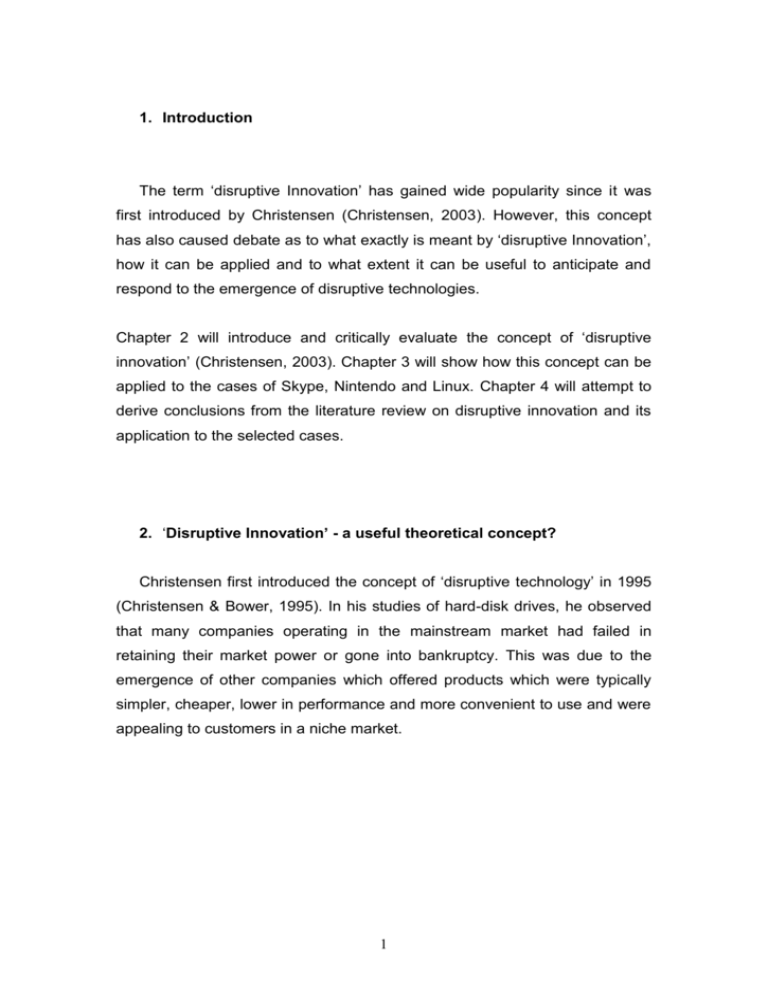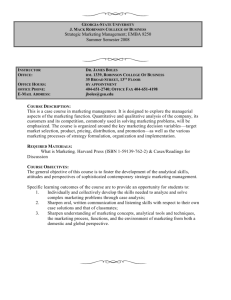Apply and critique the concept of 'disruptive Innovation'
advertisement

1. Introduction The term ‘disruptive Innovation’ has gained wide popularity since it was first introduced by Christensen (Christensen, 2003). However, this concept has also caused debate as to what exactly is meant by ‘disruptive Innovation’, how it can be applied and to what extent it can be useful to anticipate and respond to the emergence of disruptive technologies. Chapter 2 will introduce and critically evaluate the concept of ‘disruptive innovation’ (Christensen, 2003). Chapter 3 will show how this concept can be applied to the cases of Skype, Nintendo and Linux. Chapter 4 will attempt to derive conclusions from the literature review on disruptive innovation and its application to the selected cases. 2. ‘Disruptive Innovation’ - a useful theoretical concept? Christensen first introduced the concept of ‘disruptive technology’ in 1995 (Christensen & Bower, 1995). In his studies of hard-disk drives, he observed that many companies operating in the mainstream market had failed in retaining their market power or gone into bankruptcy. This was due to the emergence of other companies which offered products which were typically simpler, cheaper, lower in performance and more convenient to use and were appealing to customers in a niche market. 1 Established products became ever more complex and sophisticated over time and exceeded the ability of customers to adopt these products, while ‘disruptive technologies’ offered other features, e.g. low price, simplicity. ‘Disruptive technologies’ occurred at the low-end of the market and was initially not perceived as a threat by established firms (Christensen & Bower, 1995). Ultimately, the ‘disruptive technology’ improved in performance, expanded into a mass market and eventually replaced established technologies. Christensen distinguishes between ‘sustaining technologies’ which improve the performance of already established products in the mainstream market and ‘disruptive technologies’ which have attributes which customers in other segments of the market value (Christensen & Bower, 1995). Research emphasises that the reasons why companies invest in established markets rather than in potentially ‘disruptive technologies’ lies in the technological trajectories of companies, meaning companies do not have an unlimited choice of strategies available. A company’s opportunities are path dependent, e.g. constrained by its position, knowledge and competencies accumulated over time (Nelson & Winter, 1982 & Dosi, 1982). This makes responding to ‘disruptive technologies’ very difficult for established firms. 2 The difficulty in defining what precisely a ’disruptive technology’ is relates to the question if technologies are in themselves inherently disruptive. ‘Disruptive technologies’ can be a threat to some companies while opportunities for others, in other words they are either competence destroying or competence - enhancing (Tushman & Anderson, 1986). An example would be the internet, which may be a disruptive technology to some firms, while an opportunity to others, e.g. amazon in bookselling (Daneels, 2004). However, Christensen emphasised that competence - destroying technologies serving a mainstream market do not constitute ‘disruptive technologies’ (Christensen & Bower, 1996). This points to the possibility that it is not technologies themselves which cause the disruption to established companies but rather the impact of these technologies on firm’s internal processes, their accumulated knowledge base and competences. Therefore, Christensen eventually extended the term ‘disruptive technologies’ to ‘disruptive innovation’ to extend its potential applicability (Christensen, 2003). Nevertheless, the difficulty still remains to accurately define different types of innovation. For instance, Henderson & Clark classified innovation according to the knowledge required to develop new products which includes two dimensions: knowledge of components and knowledge of the linkages between components (Henderson & Clark, 1990). This includes incremental, modular, discontinous and architectural innovation (Henderson & Clark, 1990). 3 However, it has been pointed out that researchers classified the same innovation differently depending on their definitions (Garcia & Calantone, 2001) e.g. the electrical typewriter could be classified as ‘discontinous’ due to causing industrial disruption (Utterback, 1996) or as ‘incremental’ as it concerns adding new features for improving an already existing product (Rothwell & Gardiner, 1988). In addition, the term ‘radical innovation’ is often used interchangeably with ‘disruptive innovation’. However, while disruptive innovation refers to products which are specified as being initially cheaper, simpler and lower performing than rival products and aimed specifically at a niche market, ‘radical innovation’ seems to be broader defined and refers to a substantially different technology while offering a distinct increase in customer benefits (Chandy & Tellis, 1998). While the terminology for disruptive innovation seems to be confusing, it becomes even more complicated if the term ‘disruptive innovation’ also refers to technologies, products and business model innovations. For instance, Hamel emphasises the need for ‘business concept innovations’ by reconfiguring existing business models to enable a company to stay ahead of its competitors in a fast changing environment (Hamel, 2000). The problem arises when ‘disruptive innovation’ refers to technologies, products and business models alike as conclusions about one aspect of a specific type of ‘disruptive innovation’ cannot be generalised across all types. For instance, while Christensen shows that disruptive innovations eventually dominate the market, this is not true of business model innovations, e.g. low budget - airlines have captured approx. 20% of the entire market (Markides, 2006). This distinction has important implications as it affects the strategies established companies may want to adopt in the light of emerging, disruptive innovations elsewhere. Therefore, imitating a competitor’s product or business model may not necessarily be adequate as it may lead to an erosion of the existing customer base (Markides, 2006). 4 It is also difficult to apply the concept of ‘disruptive innovation’ across different product categories. Utterback shows that some products do not fit into this concept as some displayed in their initial stages higher performance and / or higher price than their rival product (Utterback, 2005). This may be due to the complexity of most products which usually have more performance features in comparison to the disk drives Christensen studied (Utterback, 2005). There is therefore the possibility that customers simply trade different features for others when deciding to purchase a new product (Daneels, 2004). The distinction between sustaining and disruptive innovation as proposed by Christensen is based on the innovation, product and technology lifecycle concepts. According to the innovation lifecycle model, the innovation process starts with an exploration phase of technological possibilities and market needs which are initially unknown. Over time, a dominant design emerges in the ‘transitional phase’ and the choice of options becomes focused along technological trajectories. This is followed by refining the product to improve product performance in the ‘specific phase’ (Abernathy & Utterback, 1978). The Product Lifecycle Concept (PLC) states that products follow a pattern of market development where a product is first introduced to the market, followed by market growth when demand begins to accelerate, the stage of market maturity where demand grows at the replacement rate and finally, the product enters the market decline stage where consumers lost interest and sales start to decline. The product lifecycle can be seen as an S-shaped curve (Levitt, 1965). The technology life cycle follows a similar pattern as the PLC starting with an introduction stage, where there is initially slow progress in performance due to the technology not being well known, followed by a growth phase, where the technology rapidly improves in performance around a dominant design. The 5 new technology becomes widely known and sales increase rapidly. The technology then enters a maturity phase, where progress slows down significantly (Foster, 1986 & Utterback 1994). However, it has been demonstrated that the development of technologies follows an irregular pattern with longer phases of no growth interrupted by performance jumps (Sood & Tellis, 2005). Further, new technologies may emerge above or below the performance of existing technologies and originate in established as well as in entrant firms (Sood & Tellis, 2005). The limited validity of the product lifecycle has been emphasised and research points to the fact that this model cannot be generalised across industries, products and services e.g. many brands remain in a leading market position 2 - 3 decades after their introduction (Mercer, 1993). It also remains unclear when a product enters a certain stage in the lifecycle as some products diffuse very slowly while others display rapid growth (Dhalla & Yuspeh, 1976). The length of the different stages varies between products and some products experience a sudden revival and proceed to a period of renewed growth (Dhalla & Yuspeh, 1976). In fact, the time when a product enters a specific stage of the PLC and its length depends on a variety of factors, e.g. in the initial stage this may be the perceived comparative advantage of the new product relative to the alternative, barriers to adoption or information and availability (Day, 1981). It has also been shown that the PLC model actually works in reverse order for services where innovation in processes comes first which create the necessary conditions for product innovation to occur (Barras, 1986). 6 Based on these observations, it is questionable if the concept of ‘disruptive innovation’ is useful as some ‘disruptive’ innovations do not necessarily replace older products. In addition, Varadarajan shows that incremental innovation plays a vital role as part of a competitive strategy by extending the timeframe of radical innovations (Varadarajan, 2009). This can take place by entering new markets in product categories where the firm is present, e.g. entering new markets, market segments or new geographic markets (Varadarajan, 2009). Equally, a firm may enter markets where it does not have a presence yet, e.g. entering new markets which are currently fragmented or emerging markets (Varadarajan, 2009). It may also succeed in achieving or defending product leadership, e.g. responding to price sensitivity (Varadarajan, 2009). Kanter emphasises that established firms make the mistake on focusing on the next blockbuster innovation, being too product centric and expecting immediate profits, while ignoring that incremental innovations can lead to substantial profits (Kanter, 2006). However, products in the category of ‘disruptive innovation’ do not automatically generate profit, but it rather depends on the ability of the innovator to commercialise the product successfully. Teece shows that where products can be protected through patents or copyright or the nature of the product is such that it would be difficult for competitors to imitate, the innovator is likely to profit from the innovation (Teece, 1986). Therefore, barriers to entry play an important part in determining success of new entrants (Karakaya & Stahl, 1989). For instance, a way for established firms to maintain barriers to entry and remain leader in the market may be through proprietary software systems, e.g. Microsoft has a market lead due to the windows platform as a proprietary system. 7 Christensen also seems to overlook potentially disruptive technologies which did not succeed in the market (Daneels, 2004). Established companies also have survived to ignore the emergence of disruptive technologies without it having serious consequences for their business, e.g. Sony initially failed to develop a portable MP3 player despite its dominance in the market for the walkman (Kageyama, 2005). Equally, established companies have managed to successfully respond to disruptive innovations either through internal reorganisation or establishing other organisational entities, e.g. Motorola, IBM or Kodak (Macher & Richman, 2004). Established companies usually have expertise in certain areas due to their firm - specific capacities and knowledge - base which, due to its often tacit nature, is difficult for competitors to imitate which may remain a distinct advantage for established companies. King and Tucci show that companies with prior experience in hard disk drives were most likely to enter new market niches and contradict Christensen’s findings (King & Tucci, 1999, 2002), while Chesbrough comes to similar conclusions (Chesbrough, 2003). In addition, research also showed that established firms originating in other industries are diversifying and bring their resources and transferable knowledge when entering a new market (Helfat & Lieberman, 2002). It has also been shown that prior knowledge facilitates the learning of new knowledge, meaning potential indicators for a disruptive innovation may be better recognised and processed by an established firm with accumulated knowledge in a specific field. This absorptive capacity is a necessary prerequisite for firms to make sense of new knowledge (Cohen & Levinthal, 1990). 8 Companies which are producing disruptive technologies, products or business models will compete with the tangible and intangible resources an established company has available as soon as it enters the mass market, e.g. established firms often dominate supply chains, retail channels and other distribution networks or have other complementary assets or capabilities such as marketing or after-sales support (Teece, 1986). In this case, established firms maintain their market position through joint ventures, strategic alliances or acquisitions of start-ups which provide access to the disruptive technology for established firms while at the same time providing market entrants with the vital resources (Rothaermel, 2001). Therefore, it seems that some established companies may fail when faced with the emergence of disruptive innovations, products or business models, but certainly not all of them do. A recent study of breakthrough innovations in the pharmaceutical industry has shown that radical innovation is more likely to originate in established firms. These have greater financial, technological and market - related resources to manage the risk inherent in radical innovation (Sorescu et al., 2003). However, the pharmaceutical industry maintains high barriers to entry for new entrants due to the high degree of concentration, products are protected by patents and innovation involves a substantial amount of risk and requires large financial and technological resources. Therefore, these results cannot be generalised to apply to other industries. A further study of radical innovations in the consumer durables and office products pointed to the weak empirical base of the disruptive innovation literature and emphasise that these have not used cross - sectional studies with a large sample of products. The study reveals that older innovations were indeed mainly introduced by new entrants, while recent innovations originated in established firms (Chandy & Tellis, 2000). 9 It seems that the evidence is rather inconclusive as to under which conditions firms failed when faced with disruptive innovation. Possible explanations range from the case of Polaroid and the unwillingness of senior management to embrace a potentially disruptive technology (Tripsas & Gavetti, 2000) to the role of routines and organisational inertia (Nelson & Winter, 1982).Therefore, Daneels points to the need to look at entire systems into which a firm is embedded as factors for explaining why some firms fail when faced with disruptive innovation (Daneels, 2004). 2. Case studies After reviewing the relevant literature and pointing to the limitations of ‘disruptive innovation’, this chapter will attempt to apply this concept to recent technological innovations. Rather than focusing on one particular innovation or organisation, this chapter compares three different innovations in order to derive useful conclusions regarding the validity of ‘disruptive innovation’. The cases of Skype, Nintendo Wii and Linux were selected on the basis that they are recent innovations in a product category different from those studied in the literature which makes them an interesting subject for enquiry. 2.1 Skype Skype has combined two potentially disruptive technologies, P2P (peer - to peer computing) and VoIP (Voice over Internet protocol) into a new business model and therefore radically transforming the way people communicate (Rao et al, 2004). It also added other features such as instant messaging and provides an easy - to use interface. 10 Skype can be downloaded for free and is compatible with all major operating systems. In addition, Skype is easy to install and does not require a configuration of gateways and firewalls (Tapio, 2005). Skype was founded in 1993 and initially offered lower performance in contrast to communication via landlines or mobiles, is free and easy to use and aimed at a marginal segment of the market (Tapio, 2005). Skype - Out/In was added later as a feature to make / receive calls to other networks or landlines as a charged service (Rao et al. , 2004). Skype changed the traditional marketing and revenue - based business model in the telecommunications sector by relying on a peer - to - peer based platform, free PC - to - PC telephony, its potential for scalability as well as viral marketing (Osterwalder at al., 2005). Delivery and sales channels differ substantially from conventional network providers as Skype operates entirely over the internet (Osterwalder at al., 2005). It therefore fits into the concept of ‘disruptive innovation’ as proposed by Christensen (Christensen, 2003). Faced with the disruptive innovation with the emergence of Skype, existing network providers in the telecommunications sector may find it difficult to compete against Skype as their business model is entirely based on revenue generating processes through per - call charges (Osterwalder at al., 2005). Skype equally derives revenues from SkypeIn/Out as well as other available premium features. However, its business model is based on building up a large customer base followed by the introduction of further premium services, while basic services such as Skype - to Skype calls remain free of charge (Osterwalder at al., 2005). 11 While at first glance, Skype seems a perfect example of a ‘disruptive innovation’, the next step according to the concept of ‘disruptive innovation’ would be to replace older technologies, e.g. the revenue - based business models as per - call charges of the conventional mobile & landline operators would become obsolete over time and Skype would need to shift into the mass market. As Skype was acquired by eBay, there might be possibilities to reach a mass market (Rao et al. 2004). eBay’s acquisition of Skype could lead to a potential disruption as for eBay, the partnership has the advantage of adding a free communications feature to online auctions and thereby accelerate trade, while PayPal, owned by eBay, can provide simple and secure billing for corporate customers of Skype (Rao et al 2004). Another recent partnership with the 3 network may turn out to be another route to the mass market. The Skypephone in partnership with 3 was released in August 2008 and offers free PC - to mobile as well as free mobile - to mobile calls (New Media Age, 2008). Network operator 3 tries to position itself in the market as a mobile media company by adding applications such as Skype, Facebook and Windows Live Messenger (New Media Age, 2008). Skype in turn could potentially reach a mass market in the conventional telecommunications sector by entering into partnerships with network operators (Rao et al 2004). 12 Skype’s business model and peer - to - peer technology could challenge established players in the telecommunications sector. A major erosion of revenues was expected in particularly in the business sector and affecting mainly long - distance calls (Evalueserve, 2005). In addition, mobile and landline operators have the disadvantage that they are location specific, meaning customers travelling abroad rely on roaming agreements with local operators (Tapio, 2005). However, rather than replacing the business model of conventional mobile and landline operators, it may just be the case that Skype exists alongside operators such as O2 or Vodafone as using Skype for SkypeOut calls may not always be the cheaper option, particularly for local calls (Tapio, 2005). It can be concluded, that while Skype fits into the concept of ‘disruptive innovation’, there are doubts as to whether Skype will be able to reach a mass market in the near future. Equally, it is not clear if peer - to - peer technology will actually lead to a substantial decline of revenues for conventional operators. As Skype relies on extensive partnerships in order to succeed, it seems that even though Skype’s technology and business model have disruptive potential, conventional operators still dominate the mass market for telecommunications. Therefore, it is only through co-operating with other internet - based businesses or conventional operators that Skype will succeed. 13 This conclusion confirms the earlier review of the literature that large, established companies have important distribution and sales channels as well as a large customer base at their disposal, which means high barriers to entry for new firms. Skype has so far struggled in particular to attract corporate customers (Rao et al 2004). It also confirms that the commercialisation of a disruptive innovation is unlikely to be performed by a small start - up firm without support and co-operation of the established players. 2 .2 Nintendo Nintendo, a Japanese developer of interactive entertainment software and console manufacturer, is an established player in the electronic games industry since 1977. Recently, Nintendo enjoyed phenomenal growth in sales (Datamonitor, 2008). The success of the Ninntendo Wii, launched in 2007, and its related software is due to adopting the “Blue Ocean” strategy, meaning Nintendo is no trying to compete with Sony or Microsoft in sophisticated technical features and graphic capabilities, but is mainly aiming at the casual gaming sector, in particular female and adult gamers and people who would normally not play games (Blakely, 2007). Nintendo has also introduced the Wii motion controller which responds to motions in a 3-D space, and aims at making games intuitive and accessible through motion control (Nintendo, 2008). 14 Therefore, the Nintendo Wii and its software & accessories are products which could be characterised as a disruptive innovation: The Wii console is cheaper, simpler and lower in performance than their Playstation & Xbox counterparts and is aimed at what other firms had previously regarded as the margins of the market. However, if Nintendo can be classified as an entrant firm is debatable as it has been operating in the gaming industry since 1977. This has implications for the theory of ‘disruptive innovation’ where the disruption typically originates in entrant firms or start - ups. Both Microsoft & Sony are investing considerably into developing technologically advanced hardware. The production prize for the hardware is not reflected in the purchasing prize and both console manufacturer’s business model is based on pushing revenues from selling games to make up for the losses in hardware sales (Niccolai, 2006). By developing an expensive product with sophisticated technologies, e.g. Sony offers a PS3 with Blu - ray as well as considerable memory capacity, the established console manufacturers offer a product which exceeds market adoption capacity. This would also fit into the concept of ‘disruptive innovation’. While Nintendo’s popularity is growing and quickly turning into a console for the masses through its emphasis on a social gaming experience, Sony in particular is catching up fast. In 2008, Sony has released titles such as “Buzz” or “LitteBigPlanet”, and “SingStar” still enjoys high popularity. The recent release of the virtual environment “Home” adds a social space where users can meet online, chat and play games. Faced with Nintendo’s success, Sony is now trying to establish itself in casual, family - friendly gaming, while on the other hand still maintaining its hardcore gaming business (Yin - Poole, 2008) 15 Christensen recommends that Sony should “[…] think about how they can disrupt the disruptor and find a new way to redefine the space” (Christensen, 2007) rather than imitating the competitor’s products. While Nintendo Wii can be classified as a ‘disruptive innovation’ which has already penetrated the mass market, it is questionable as to whether Sony & Microsoft as established firms in the market will eventually cease to make profit. It seems that the Wii console will more likely coexist with the Playstation and Xbox as Nintendo offers a substantially different product range in contrast to Sony & Microsoft (Gamasutra, 2007). Another point to consider is that technological development, particularly in the games industry is moving at a very rapid pace and eventually, a demand for higher performing technologies may emerge, once casual gamers are introduced to gaming. This means that Nintendo would have to compete in the foreseeable future with large firms with years of accumulated knowledge and technological capabilities. 2.3 Linux Linux is an operating system based on the Free and Open Source Software (FOSS) development and is therefore free and its source code is accessible and can be modified and distributed under the GNU General Public license (Molinie at al., 2005). As any other open source software such as MySQL or Apache, Linux is developed by individual programmers who collaborate on a voluntary basis in a decentralised network (Molinie at al., 2005). 16 The Linux operating system therefore fits into Christensen’s model of ‘disruptive innovation’ as it has been developed as a free software aimed at a niche market and initially fulfilled the characteristics of lower performing, cheaper, though not necessarily simpler to use in comparison with its rival products. It has been shown that the impact of Linux on established firms in the software market has been mixed: while it has forced some competitor’s product out of the market or rethink their strategies e.g. the Apache project’s impact on IBM, it has not been successful so far in the mass market, e.g. desktop operating systems (Brydon & Vining, 2008). Linux has found widespread use as an operating system mainly in a corporate or government environment, but has not yet entered the mass market, even though software for the desktop market which compares well with Microsoft Windows in terms of technical performance and user - friendliness has been developed (Molinie et al, 2005). One important aspect of Linux is that it is a knowledge creating network of customers and suppliers who continuously exchange knowledge and value (Ballantyne, 2002). This network enables innovation and the creation of ideas and solutions through collaboration and a deliberate knowledge spill-over effect in an open network (Ballantyne, 2002). Many companies have installed Linux as it supports innovation processes (Brydon & Vining, 2006). Other firms such as IBM or Sun Microsystems actively participate in open source software development as it facilitates the selling of complementary products and services (Brydon & Vining, 2006). 17 The Linux operating system also enables agility and flexibility rather than being “locked-in” to one particular system where the customer is unable to switch to a different product or service (Hicks & Pachamanova, 2007). Despite the advantages of open source software, in particular Microsoft remains a dominant player in the software market due to the high switching costs firms would face if they migrated to Linux, e.g. the need for retraining and data stored in proprietary data models (Brydon & Vining, 2006). Further problems arise when required software components are not developed by the open source community and there is also no guarantee that existing hardware or software will be compatible with future versions of the operating system Linux (Bitzer & Schröder, 2007). While Microsoft has responded to the open source software development initially with hostility, it now actively participates in open source development. Sami Ramji, Senior Director of Platform Strategy, has emphasised the commitment towards driving Microsoft’s Linux and open source strategy and working with the open source community at the Apache conference in 2008 (Ramji, 2008). This was also shown with the acquisition of the search engine Powerset Inc. in 2008, where source code as part of the product is redistributed into the Apache’s Software Foundation Hadoop’s project (Montalbano, 2008). In addition, Microsoft started to contribute code to a patch to ADOdb, a data access layer for PHP, which is also open source (Montalbano, 2008). 18 It can be concluded that while Linux has not yet reached a mass market penetration, there are signs that it has certainly disruptive potential. Microsoft started to take open source more seriously and seems to follow a dual strategy of both maintaining its position in the market through proprietary software and at the same time participating in the open source network. At this point, it is difficult to predict if Linux will eventually replace Windows as an operating system, but if Microsoft starts to invest significant resources into open source, the competitive advantage of Linux may eventually decline. While Linux can be classified as a disruptive innovation, incremental innovation through collaboration in an open, decentralised network is the essence of any open source software. This once again relates to the literature discussed earlier, that for some products, incremental innovation will remain vital throughout their lifecycle. 3. Conclusion From the literature review of ‘disruptive innovation’ and its application to the selected case studies, the concept of ‘disruptive innovation’ is certainly appealing, but has limited practical value as it cannot be generalised across industries, technologies, products and business models. Christensen criticises that a one - size fits all approach, e.g. developing products which are a continuation of an existing product line, will not lead companies to succeed in the market. While he emphasises the importance of ‘disruptive innovation’, he fails to show how innovation processes differ across industries and product ranges and essentially prescribes ‘disruptive innovation’ as standard (Christensen, 2003). 19 Furthermore, it is largely based on theoretical assumptions which can be regarded as problematic, e.g. the validity of the product lifecycle. In addition, while ‘disruptive innovation’ focuses entirely on new product development, it underestimates the vital importance of incremental innovation. While disruptive innovation may be applicable to some products, technologies and services, reality in most cases is far more complex. It has been demonstrated that adoption of products, technologies and services depend on a variety of interrelated factors. Equally, innovation does not occur in a vacuum, but usually in a complex network of customers and suppliers embedded in national systems of innovation (Freeman, 2002). The case studies have also shown that due to the complexity of product development, it is difficult to make ex - ante predictions of successful, disruptive innovations. Even if they do occur, it seems difficult to attribute its commercialisation to a single factor. The ‘disruptive innovation’ literature fails to take into account that business innovation is systemic in nature (Sawhney et al., 2006). Christensen argues that the uncertain process of ‘disruptive innovation’ can be managed by focusing almost entirely on assessing existing market demand through effective market segmentation (Christensen, 2003). However, it has been shown that traditional market research techniques may be of limited value to address emerging markets (Hassan, 2008). It has also been demonstrated that disruptive innovation can originate as much in established as in entrant firms and that often, entrant firms rely on cooperation with resources of large, established firms to enter the mass market and successfully commercialise an innovation. Therefore, future research would need to address how firms can balance a portfolio of different types of innovation and analyse the complex environment 20 firms operate in as well as taking into account that the resulting conclusions are case and context specific. 21 References Abernathy, W. & Utterback, J. (1978). Patterns of industrial innovation. Technology Review, Vol. 80 (7), 41- 47 Agarwal, R. & Gort, M. (2002): Firm and Product Lifecycle and Firm Survival, Technological Change, Vol. 92 (2), pp. 184 - 190 Ballantyne, D. (2002.): The Case of Linux: Global Challenger to Microsoft’s Hegemony? [online], Monash University, Paper presented at the EMAC/ANZMAC Conference on Marketing Networks in a Global Economy, Perth, available at http://smib.vuw.ac.nz:8081/www/Ballantyne.pdf, accessed 28/12/2008 Blakely, Rhys (2007): Wii are swimming in a clear blue ocean, [online] Times online, available at http://business.timesonline.co.uk/tol/business/industrysectors/technology/article2063714.ece , accessed 2/01/2009 Barras, R. (1986): Towards a Theory of Innovation in Services, Research Policy, Vol.15, pp. 161-173 Bitzer, J. & Schroeder, P. (2007): Open Source Software, Competition and Innovation, Industry and Innovation, Vol. 14 (5), 461- 476 Bower, J. & Christensen, C. (1995): Disruptive Technologies: Catching the Wave, Harvard Business Review, Vol. 73 (1), pp. 43 – 53 22 Brydon, M & Vining, A. (2008): Adoption, Improvement and Disruption: Predicting the Impact of Open Source Applications in Enterprise Software Markets, Journal of Database Management, Volume 19 (2), pp. 73 - 94 Chandy, R. & Tellis, G. (1998), Organizing for Radical Product Innovation: The Overlooked Role of Willingness to Cannibalize,” Journal of Marketing Research, Vol. 35, pp. 474 - 87 Chandy, R. & Tellis, G. (2000): The Incumbent’s Curse? Incumbency, Size, and Radical Product Innovation, Journal of Marketing, Vol. 64 (3), pp. 1 - 17 Charitou, C. & Markides, C. (2003): Responses to Disruptive Strategic Innovation, MIT Sloan Management Review, Vol. 44 (2), pp. 55 – 63 Chesbrough, Henry (2003). Environmental Influences upon Firm Entry into New Submarkets: Evidence from the Worldwide HardDisk-Drive Industry, Research Policy, Vol. 32 (4), pp. 403 – 21 Christensen, C. & Bower, J. (1996): Customer Power, Strategic Investment, and the Failure of Leading Firms, Strategic Management Journal, Vol.17 (3), pp. 197 - 218. Christensen, C. (1997): The Innovator’s Dilemma. When New Technologies Cause Great Firms to Fail, Harvard Business School Press Christensen, C. & Overdorf, M. (2000): Meeting the Challenge of Disruptive Change, Harvard Business Review, Vol. 78 (2), pp. 67-76 23 Christensen, C. & Raynor, M. (2003): The Innovator’s Solution. Creating and Sustaining Successful Growth, Harvard Business School Press Christensen, C. (2007): Sony Strategy - what they should do next, [online] available at http://www.easy-strategy.com/sony-strategy.html, accessed 3/01.2009 Cohen, W. & Levinthal, D. (1990).: Absorptive Capacity: A new Perspective on Learning and Innovation, Administrative Science Quarterly, Vol. 35 (1), pp. 128 -152 Danneels, E. (2004): Disruptive Technology Reconsidered: A Critique and Research Agenda, Journal of Product Innovation Management, Vol. 21 (4), pp. 246 - 258 Dhalla, N. & Yuspeh, S. (1976): Forget the Product Life Cycle concept!, Harvard Business Review, Vol. 54 (1), pp. 102-112 Datamonitor (2008): Nintendo Co. Ltd. - company profile, London Day, G. (1981): The Product Lifecycle: Analysis and Applications Issues, Journal of Marketing, Vol. 45, pp. 60-67. Day, G. & Schoemaker, P. (2000): Avoiding the Pitfalls of Emerging Technologies, California Management Review, Vol. 42 (2), pp. 8 - 33 Day, G. & Schoemaker, P. (2000): Don't Hesitate to Innovate. Financial Times, Mastering Management Series, Part Two, pp. 4 - 6 24 Dosi, G. (1982): Technological Paradigms and Technological Trajectories. Research Policy, Vol. 11 (3), pp. 147-162 Evalueserve (2005): Impact of Skype on Telecom Service Providers [online] available at January10.pdf, http://www.commnow.com/reports/EVS-Impact_of_Skype_on_Tele_Opr- accessed 6/01/2009 Foster, R. (1986): The Attacker’s Advantage, Macmillan, London Freeman, C. (2002): Continental, National and Sub-national Innovation Systems - Complementary and Economic Growth, Research Policy, Vol. 31, pp. 191 - 211 Freeman, C. & Soete, L. (1997): The Economics of Industrial Innovation, 3rd ed. MIT Press, Cambridge, MA. Gamasutra (2007): MIGS Panel Asks 'Is The Wii Really Broadening The Market?' [online] bin/news_index.php?story=16590, available at http://www.gamasutra.com/php- accessed 3/01/2009 Garcia, R. & Calantone, R. (2002): A Critical Look at Technological Innovation Typology and Innovativeness Terminology: a Literature Review, The Journal of Product Innovation Management, Vol.19 (2), pp. 110 - 132 Glazer, Rashi (2007): Meta - Technologies and Innovation Leadership: Why there may be nothing new under the sun, California Management Review, Vol. 50 (1), pp. 120 - 125 Gilbert, Clark (2003): The Disruptive Opportunity, MIT Sloan Management Review, Vol. 6, pp. 23 - 31 25 Gilbert, C. & Bower, J. (2002): Disruptive Change: When Trying Harder Is Part of the Problem, Harvard Business Review, Vol. 80 (5), pp. 94 101 Golder, P. & Tellis, G. (2004): Growing, Growing, Gone: Cascades, Diffusion and Turning Points in the Product Lifecycle, Marketing Science, Vol. 23 (2), pp. 207 - 218 Hamel, G. (2000): Leading the Revolution, Harvard Business School Press, Boston, Massachusetts Hassan, S. (2008): Bringing Lead - user innovations to the Market: Research and Management Implications, S.A.M Advanced Management Journal, Vol. 73 (4), pp. 51 – 58 Helfat, C. & Lieberman, M. (2002): The Birth of Capabilities: Market Entry and the Importance of Prehistory, Industrial and Corporate Change, Vol. 11 (4), pp. 725 - 60. Henderson, R. & Clark, K. (1990): Architectural Innovation: The Reconfiguration of Existing Product Technologies and the Failure of Established Firms., Administrative Science Quarterly, Vol. 35 (1), pp. 9 – 30 Hicks, C. & Pachamanova, D. (2007): Back-propagation of user innovations: The open source compatibility edge, Business Horizons, Vol. 50 (4), pp. 315 – 324 Kageyama, Y. (2005): Sony admits MP3 error, [online] available at http://www.australianit.news.com.au/story/0,24897,12005964-15345,00.html, accessed 5/01/2009 Kanter, R. (2006): Innovation: The Classic Traps, Harvard Business Review, Vol. 84 (11), 73 - 83 26 Karakaya, F. & Stahl, M. (1986): Barriers to Entry and Market Entry Decisions in Consumer and Industrial Goods Markets, Journal of Marketing Vol. 53, pp. 80 - 91 Kapko, M. (2007): Gaming nerds may drive innovation, but casual garners drive market, RCR Wireless News, Vol. 26 (20), p.15 Klepper, S. (1996): Entry, Exit, Growth and Innovation over the Product Lifecycle, American Economic Review, Vol. 86 (3), pp. 562 – 583 King, A. & Tucci, C. (1999): Can Old Disk-Drive Companies Learn New Tricks? Proceedings of the 6th Annual International Product Development Management Conference. Cambridge, UK. King, A. & Tucci, C. (2002): Incumbent Entry into New Market Niches: The Role of Experience and Managerial Choice in the Creation of Dynamic Capabilities, Management Science, Vol. 48(2), pp. 171 - 86 Levitt, T. (1965): Exploit the Product Life Cycle, Harvard Business Review; Vol. 43 (6), pp. 81 – 94 Macher, J. & Richman, B. (2004): Organisational Responses to Discontinous Innovation: A Case Study Approach, International Journal of Innovation Management, Vol. 8 (1), pp. 87–114 Levitt, B. & March, J. (1988): Organizational Learning, Annual Review of Sociology, Vol. 14, pp. 319 - 340 Malerba, F. (2002.): Sectoral Systems of Innovation and Production, Research Policy, Vol. 31 (2), pp. 247 - 264 Markides, C. (2006): Disruptive Innovation: In Need of Better Theory, Journal of Product Innovation Management, Vol. 23 (1), pp. 19 - 25 27 Mercer, D. (1993): A Two - Decade Test of Product Lifecycle Theory, British Journal of Management, Vol. 4, pp. 269-274 Molinie et al. (2005): Open Source Technology Adoption: An Exploratory Study of the Linux Market Share, http://www.lrgl.uqam.ca/publications/pdf/933.pdf, [online] available at accessed 4/01/2009 Montalbano, E. (2008): Microsoft revising ‘us vs. them’ attitude toward open source, Linuxworld, [online] available at http://www.linuxworld.com.au/article/270378/microsoft_revising_us_vs_them_attitude_toward _open_source, accessed 2/01/2009 Nelson, R. & Winter, S. (1982): An Evolutionary Theory of Economic Change, Belknap, Cambridge, MA. New Media Age (2008): Spreading out: 3 is moving beyond its roots as an operator and content operator to encompass all forms of online communication, London, 9/10/2008 Niccolai, A. (2006): Sony loses big money on PS3 hardware, PC World, available at http://www.pcworld.com/article/127906/sony_losing_big_money_on_ps3_hardware.html, accessed 2/01/2009 Nintendo (2009): Introducing Wii Motion Plus, Nintendo’s upcoming accessory for the revolutionary Wii remote, [online] available http://www.nintendo.com/whatsnew/detail/eMMuRj_N6vntHPDycCJAKWhEO9zBvyPH , accessed 2/01/2009 28 at Osterwalder at al. (2005): Skype’s Disruptive Potential in the Telecom Market: A Systematic Comparison of Business Models [online] HEC Lausanne Working Paper, available at http://www.janondrus.com/wp-content/uploads/2008/07/05skype.pdf, accessed 2/01/2009 Overdorf, M. (2000): Meeting the Challenge of Disruptive Innovation, Harvard Business Review, Vol. 78 (2), pp. 66 - 76 Ramji, Sami (2008): Apache Conference 2008, [online] available at http://apacheconus2008.crowdvine.com/talks/show/2775, accessed 3/01/2009 Rao et al. (2004): Fusion of Disruptive Technologies: Lessons from the Skype Case, European Management Journal, Vol. 24 (2–3), pp. 174 - 188 Rothaermel, F. (2001): Incumbent’s Advantage through Exploiting Complementary Assets via Interfirm Cooperation, Strategic Management Journal, Vol. 22 (6 - 7), pp. 687 - 99 Rothwell R. & Gardiner P. (1988): Reinnovation and Robust Designs: Producer and User Benefits, Journal of Marketing Management, Vol. 3 (3), pp. 372 - 387 Rice et al. (2001): Radical Innovation: Triggering Initiation of Opportunity Recognition and Evaluation, R&D Management, Vol. 31 (4), pp. 409 – 427 Sawhney et al. (2008): The 12 Different Ways for Companies to Innovate, MIT Sloan Management Review, Vol. 47 (3), pp. 75 – 86 Schmidt, G. & Druehl, C. (2008): When is a Disruptive Innovation Disruptive?, Journal of Product Innovation Management, Vol. 25 (4), pp. 347 – 369 Scott, R. (2008): Casual is the New Hardcore, Electronic Gaming Monthly, Issue 230, p. 72 29 Sood, A. & Tellis, G. (2005): Technological Evolution and Radical Innovation, Journal of Marketing, Vol. 69 (3), pp. 152 - 168 Sorescu et al., (2003): Sources and Financial Consequences of Radical Innovation: Insights from Pharmaceuticals, Journal of Marketing, Vol. 67, (4) pp. 82 - 102 Tapio, A. (2005): Future of Telecommunication - Internet Telephony Operator Skype, [online] Helsinki University http://www.tml.tkk.fi/Publications/C/18/tapio.pdf, of Technology, available at 4/01/2009 Teece et al. (1997): Dynamic Capabilities and Strategic Management, Strategic Management Journal, 18 (7), pp. 509 – 533 Tidd et al. (2005): Managing Innovation. Integrating Technological, Market and Organisational Change, 3rd edition, John Wiley & Sons Ltd. Trott, P. (2008): Innovation Management and New Product Development, 4th edition, Prentice Hall Tushman, M. & Anderson, P. (1986) Technological discontinuities and organizational environments., Administrative Science Quarterly, Vol. 31 (3), pp. 439 - 465 Tushman, M. & Anderson, P. (2004): Managing Strategic Innovation and Change, 2nd edition, Oxford University Press Tripsas, M. & Gavetti, G. (2000): Capabilities, Cognition and Inertia: Evidence from Digital Imaging, Strategic Management Journal, Vol. 21 (10/11), pp. 1147 - 1161 Utterback, J. (1994): Mastering the Dynamics of Innovation, Harvard Business School Press, Boston 30 Utterback, J. & Acee, H. (2005): Disruptive Technologies: an Expanded View, International Journal of Innovation Management Vol. 9 (1), pp. 1 -17 Varadarajan, R. (2009): Fortune at the Bottom of the Innovation Pyramid: the Strategic Logic of Incremental Innovations, Business Horizons, Vol. 52, pp. 21- 29 Yin - Poole, W. (2008): Sony: We haven’t fallen behind in social gaming, Videogamer, [online] available http://www.videogamer.com/ps3/little_big_planet/news-9767.html, 31 at accessed 3/01/ 2009









